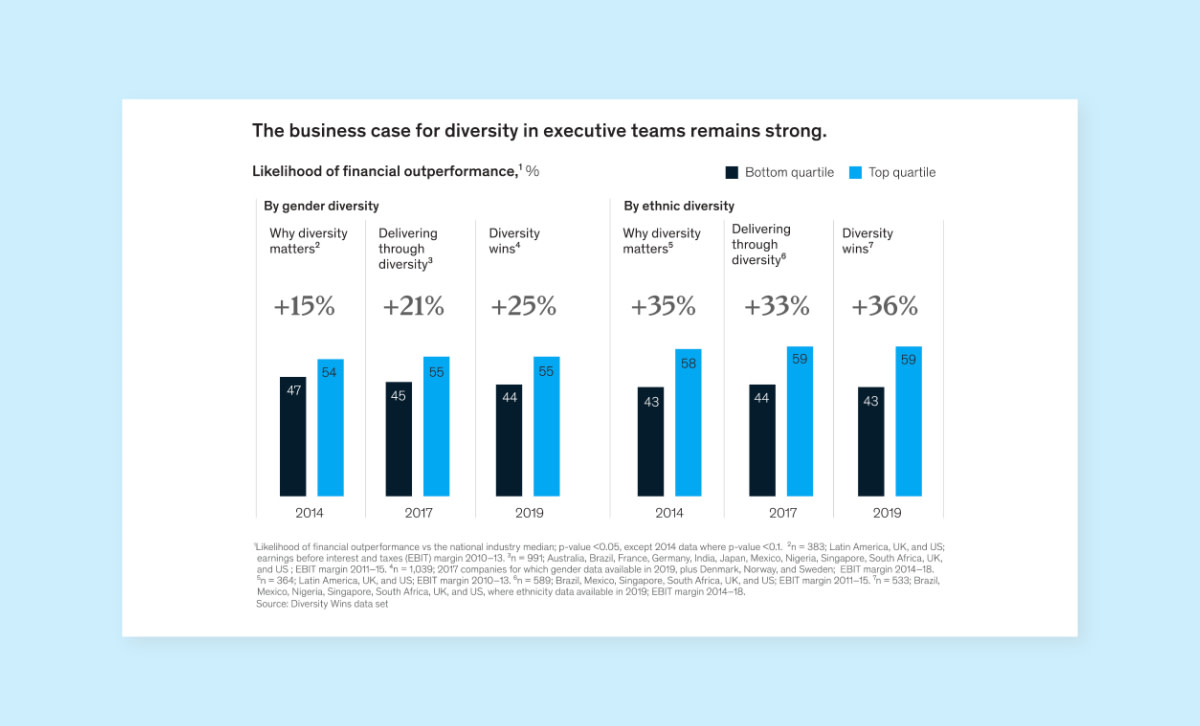5 Ways to Improve Diversity Recruiting Efforts
Increasing workplace diversity is tablestakes for organizations. Here are five ways to to improve diversity in recruitment.

The Black Lives Matter (BLM) movement has placed a magnifying glass on the state of workplace diversity at organizations in all industries. The BLM movement has stirred companies to finally make diversity and inclusion tablestakes and according to this NPR piece, leaders are examining how they can do better throughout the employee lifecycle.
With talent acquisition usually an individual’s first encounter with your company, it’s more important than ever to improve your diversity recruiting efforts. Here, we look at how talent acquisition analytics enables you to quickly identify the roadblocks in attracting and hiring diverse candidates, and develop fact-based strategies to eliminate bias and improve diversity in your hiring funnel.
What is diversity recruiting and why is it important to success?
Diversity recruiting means being more thoughtful in granting everyone equal access to employment opportunities and also opening your doors to a wider range of talent that may be just the very thing you need to succeed in today’s volatile business climate.
New 2020 research from McKinsey has shown time and time again that organizations with diverse and inclusive workforces win:
Top-quartile companies outperformed those in the fourth one by 36 percent in profitability, slightly up from 33 percent in 2017 and 35 percent in 2014
Companies in the top quartile for gender diversity on executive teams were 25% more likely to have above-average profitability than companies in the fourth quartile—up from 21 percent in 2017 and 15 percent in 2014
Companies with more than 30 percent women executives were more likely to outperform companies where this percentage ranged from 10 to 30, and in turn these companies were more likely to outperform those with even fewer women executives, or none at all.

McKinsey graphic showing that the likelihood for financial performance by gender diversity and ethnic diversity has been increasing steadily since 2014
Additionally, Edelman research on racial justice and brands in America found 60% of people will boycott a brand if they’re not aligned to their values. Talent Acquisition leaders have a critical role to play in not only supporting more workplace diversity, but ensuring their recruiting and hiring strategies are fair and unbiased.
As I’ve mentioned previously, data-driven recruitment is the difference between making decisions on gut feeling and making them based on facts. It’s the difference between making a successful impact on business outcomes and failing to move the business needle.
For a leading industrial manufacturer, they used to spend more than six months analyzing their diversity numbers and hiring funnel, they now use people analytics to easily and quickly perform analyses on their recruiting funnel. In one case, the data revealed there were more male applicants than females, and more women were dropped during the interview process. This led the organization to implement unconscious bias training for hiring managers, as well as workshops on inclusive conversations.
How to improve diversity in recruitment
As the customer story above shows, people analytics isn’t just for analysts. New technologies allow every talent acquisition professional–no matter your data-savviness–to explore your people data from hire to retire and surface key information that will create more equitable hiring processes.
Additionally, look for people analytics solutions that provide data-driven answers to recruiting problems in minutes so your recruiters can act on opportunities and roadblocks quickly.
From beginning to end, a data-driven approach to recruitment creates a more diverse and engaged workforce. Here are five areas analytics can help strengthen your diversity recruiting, which can also be applied towards other recruiting priorities beyond D&I:
1. Examine your current employee population
While it may be tempting to go after all types of people and hope something sticks, the reality is, different types of people will require different marketing programs to attract them to you as an employer. Some of these initiatives might be more expensive than others. This is why it’s important to take a scientific approach to building the right strategy for your talent acquisition efforts.
The first step is to identify where your diversity gaps are. Use analytics to look at your current employee population and examine headcount by gender, race, veteran status, etc. This process will reveal insights such as whether your organization needs more minority races in executive leadership or maybe, more women in STEM roles.
Once you know where you stand, you can work with business leaders to determine which diversity goals are more important and allocate budget towards these initiatives accordingly.
2. Get more diversity into your hiring funnel
When hiring managers are pressuring your recruiters to hire critical positions as quickly as possible, it can be easy to forget about adding diversity in your funnel. A data-driven recruiter continuously monitors the funnel to see whether diversity increases or decreases as candidates move through the pipeline.
Use analytics to keep track of diversity ratios — i.e. for gender, ethnicity, and veteran status — in aggregate for every stage in the hiring funnel. This will make it clear where in your hiring process you lose your diverse candidates. Dig into your sourcing data to also find where your most diverse candidates pools are and double down on recruiting from those sources, including internal candidates.

3. Better match interviewers to candidates
Research shows that there is reduced bias when the diversity of a job interviewer is matched to the candidate. In fact, the 2020 Inclusion Index by Diversity Best Practices, revealed that of the 98 organizations surveyed (a list that includes Johnson & Johnson, Accenture, New York Life, and more), 75% require the panel of interviewers to be diverse.
Use your people analytics to monitor how matching the gender or ethnicity, for example, of the interviewer to a candidate has an impact on your hiring process. Are more, less, or the same number of diverse candidates moving through the funnel? Make adjustments as necessary.
4. Go beyond homogenous diversity numbers
It’s not enough to say ‘diversity went up by 10%.’ When improving workforce diversity is one of your business objectives, it’s essential to keep track of hiring success rates by diversity group. For example, if the goal was to hire more veterans, you need to be able to show how many were successfully hired. Workforce analytics easily separates your diverse candidates by group and shows you how successful you were in each category.
Guided people analytics made it easier for the HR team at Empower AI (formerly NCI) to not only understand how the calculations are made, but also enable them to explain the reasoning behind the numbers to managers.
“Instead of managers saying, ‘recruiting is not getting me enough candidates,’ we can show them the data that shows they got 50 candidates, but the lengthy interview process resulted in candidate attrition,” said Clay Worley, CHRO.
5. Keep track of your post-hire data
How your diverse hires fare long-term at your organization reveals important insights about your hiring practices. How long these employees stay at the company, how they perform, and how soon they receive promotions can tell you about the quality of your diverse hires.
If you have all your pre-hire and post-hire data systems connected in one platform, you can regularly analyze the performance of diverse employees and keep an eye on promotions that they received (as well as when in their tenure they achieved these). These insights will help you identify high quality and diverse employees. Use this information to recreate the steps you took to hire them in the first place, so you can continuously attract and hire diverse and high potential employees.
Take action on your diversity recruiting strategies today
Organizations that want to succeed in 2020 and beyond must no longer look at a diverse, inclusive, and equitable workplace as a nice-to-have. In this Harvard Business Review article, researchers identified that the hard work for leaders is taking in the data and taking action as a result.
The key to not leaving aside your DEI policies is to make sure they are embedded into decision-making processes. As the five areas of focus above show, making people data easy for your recruiters to find and use can create positive change at your organization. From beginning to end, a data-driven approach creates a more diverse hiring funnel and a much stronger workforce.


